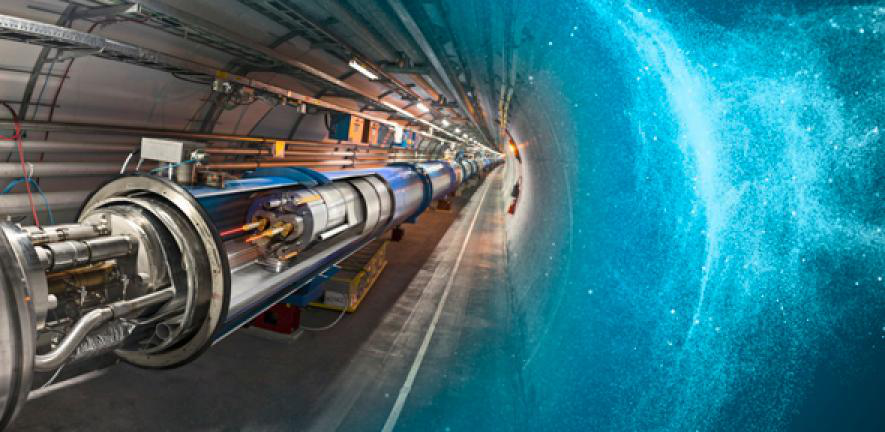Conveners
Parallel Session VI, Instrumentation
- Betty Kibirige (University of Zululand)
- Mohamed Gouighri (Ibn Tofail University)
The ATLAS experiment at the large hadron collider relies on very large samples of simulated events that are required in the majority of physics analysis and performance studies in the ATLAS physics program. Producing such a huge number of simulated events using the Geant4 framework consumes the CPU resources. The challenge is that in the high luminosity phase of LHC, the average number of...
We develop a machine learning-based generative model, using scikit-learn to generate a list of particle four-momenta from the Large Hadron Collider (LHC) proton-proton collisions. This method estimates the kernel density of the data using the Gaussian kernel and then generates additional samples from this distribution. As an example of application, we demonstrate the ability of this approach...
The goals of the upgrades of the ATLAS Muon Spectrometer with new small-diameter Muon Drift Tube Chambers (so-called sMDT) are to make room to install new triple-Resistive Plate Chambers (tRPC) to increase the trigger efficiency in the inner barrel muon region and to improve the rate capability of the muon chambers in the high background regions corresponding to the HL-LHC project. As a pilot...
The ATLAS Inner Detector (ID) trigger is a crucial component in the ATLAS trigger system, and plays a pivotal role in the high quality reconstruction of the physics objects - electron, muon, tau and b-jet candidates. These objects are fundamental for physics studies and analyses at ATLAS. The ATLAS ID trigger was redesigned during 2013-2015 shutdown, this provided the opportunity to improve...
The ATLAS Tile Calorimeter is a hadronic sampling calorimeter that plays a major role in jet energy scale measurements. Accurate reconstruction of jets a vital role for precision measurements of the Standard Model and for searches of physics beyond the Standard Model.The jet energy scale is measured assuming uniformity of response in the azimuthal direction of both the Liquid Argon and Tile...
The resistive plate chamber (RPC) is a fast gaseous detector that provides a muon trigger system parallel with the drift tubes and cathode strip chambers in the CMS experiment. It consists of two parallel plates, a positively-charged anode and a negatively-charged cathode, both made of a very high resistivity plastic material and separated by a gas volume. It is used in many high-energy...
During Phase I upgrade of the Tile Calorimeter of the ATLAS experiment, the characterization and qualification of assembled E3 and E4 scintillator counters (Crack) was conducted through manual scans using a strontium-90 radioactive source and a small scanbox containing a photomultiplier tube. The Crack counter, clear optical fiber cable and connections were exposed making transmitted...
Plugin based system for assessing the quality of data and conditions for ATLAS Tile Calorimeters is known as the Tile-in-One (TiO). The TiO is a collection of small sized independent web tools called plugins, designed to make it easier for a user to evaluate Tile Calorimeter (TileCal) data. TiO platform aims to integrate individual TileCal web tools into a single common platform, which will...
The upgrade of the ATLAS hadronic tile-calorimeter (TileCal) Low-Voltage Power Supply (LVPS) falls under the high-luminosity LHC upgrade project. This presentation serves to provide a detailed overview of the development of a Burn-in test station for use on an upgraded LVPS component known as a Brick. These Bricks are radiation hard transformer-coupled buck converters that function to...
Irradiation campaigns have been carried out in a variety of European facilities to select radiation hard candidates for the upgraded version of the transformer coupled buck converter (Brick). The ATLAS detector is set to undergo a significant upgrade termed the "Phase-II" Upgrade. This talk primarily focuses on the exposure of selected active components (power MOSFETs, MOSFET drivers and...
The main purpose of the ATLAS experiment is to study the proton-proton collisions from the Large Hadron Collider (LHC) in order to exploit the full discovery potential of the LHC. ATLAS' exploration uses precision measurement to push the frontiers of knowledge by seeking answers to fundamental questions.
A new phase called High Luminosity LHC (Run4) will start operation in mid-2026, which...
A muon collider is very promising for the future of high energy physics and is becoming a realistic option. It combines the high precision of electron-positron machines, with a low level of beamstrahlung and synchrotron radiation, and the high centre-of-mass energy and luminosity of hadron colliders. Beams with an intensity of the order of 10$^{12}$ muons per bunch are necessary to obtain the...
In this study, the incorporation of 0D and 1D carbon nanomaterials in a commercial thermal interface material is reported to enhance the heat transfer of electronic devices. The investigated thermal interface materials were fabricated following a protocol based on sonication of the carbon nanomaterials and the thermal compound in acetone at 55 °C. In order to test the applicability of the...

